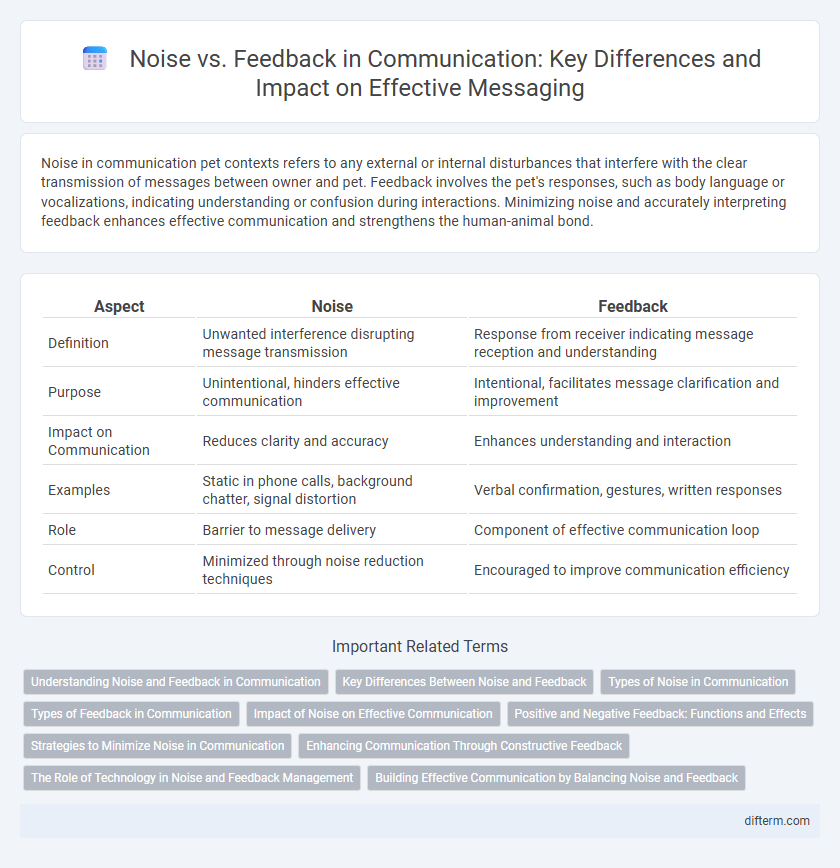Noise in communication pet contexts refers to any external or internal disturbances that interfere with the clear transmission of messages between owner and pet. Feedback involves the pet's responses, such as body language or vocalizations, indicating understanding or confusion during interactions. Minimizing noise and accurately interpreting feedback enhances effective communication and strengthens the human-animal bond.
Table of Comparison
| Aspect | Noise | Feedback |
|---|---|---|
| Definition | Unwanted interference disrupting message transmission | Response from receiver indicating message reception and understanding |
| Purpose | Unintentional, hinders effective communication | Intentional, facilitates message clarification and improvement |
| Impact on Communication | Reduces clarity and accuracy | Enhances understanding and interaction |
| Examples | Static in phone calls, background chatter, signal distortion | Verbal confirmation, gestures, written responses |
| Role | Barrier to message delivery | Component of effective communication loop |
| Control | Minimized through noise reduction techniques | Encouraged to improve communication efficiency |
Understanding Noise and Feedback in Communication
Noise in communication refers to any interference that distorts the message, such as physical sounds, psychological distractions, or semantic misunderstandings. Feedback is the receiver's response that confirms whether the message was understood correctly, thus enabling adjustments to improve clarity and effectiveness. Recognizing the role of noise and feedback is essential for optimizing communication accuracy and minimizing errors in message transmission.
Key Differences Between Noise and Feedback
Noise refers to any unwanted interference that distorts or disrupts the clarity of a communication signal, reducing message accuracy. Feedback is the receiver's response to the sender, facilitating message verification, enabling adjustments, and enhancing effective communication. The key difference lies in noise hindering understanding, while feedback actively improves interaction by providing constructive input.
Types of Noise in Communication
Types of noise in communication include physical noise, such as environmental sounds that disrupt message transmission, and psychological noise, which involves mental distractions or emotional barriers affecting message interpretation. Semantic noise occurs when language or symbols are misunderstood due to differences in meaning or cultural context. Technical noise relates to disruptions in communication channels, like poor signal or equipment failure, hindering clear message delivery.
Types of Feedback in Communication
Feedback in communication includes positive, negative, and constructive types, each playing a crucial role in message clarity and effectiveness. Positive feedback reinforces the sender's message, promoting confidence and motivation, while negative feedback highlights errors or misunderstandings that require correction. Constructive feedback offers specific, actionable suggestions, fostering improvement and facilitating continuous dialogue despite the presence of noise disruptions.
Impact of Noise on Effective Communication
Noise disrupts the clarity and accuracy of the message, causing misunderstandings and reducing the effectiveness of communication. It interferes with the receiver's ability to interpret information as intended, leading to errors and decreased engagement. Persistent noise in communication channels compromises feedback quality, hindering the corrective process essential for improving message delivery.
Positive and Negative Feedback: Functions and Effects
Positive feedback reinforces desired communication behaviors by encouraging repetition and enhancing motivation, while negative feedback identifies areas needing improvement, promoting corrective actions and learning. In communication processes, positive feedback strengthens message clarity and rapport, whereas negative feedback helps maintain accuracy and prevent misunderstandings. Effective use of both types optimizes interaction quality, fostering continuous improvement and mutual understanding.
Strategies to Minimize Noise in Communication
Effective strategies to minimize noise in communication include choosing clear and concise language that reduces misunderstandings and employing active listening techniques to ensure accurate message reception. Utilizing technology such as noise-cancelling headphones and ensuring proper channel selection helps filter out physical and environmental distractions. Regular feedback loops allow for clarification, confirming message accuracy, and strengthening overall communication effectiveness.
Enhancing Communication Through Constructive Feedback
Constructive feedback plays a critical role in enhancing communication by clarifying messages and reducing noise, which often distorts the receiver's understanding. By providing specific, actionable insights, feedback helps to eliminate barriers such as misinterpretations, distractions, and emotional interference. Effective feedback mechanisms foster a transparent dialogue environment, improving message accuracy and overall communication efficiency.
The Role of Technology in Noise and Feedback Management
Technology plays a crucial role in managing noise and feedback in communication systems by utilizing advanced filters, noise-canceling algorithms, and adaptive feedback suppressors. Modern communication devices integrate AI-powered noise reduction to distinguish between background noise and relevant signals, enhancing message clarity. Digital platforms also offer real-time feedback monitoring tools that help users adjust audio settings to prevent distortion and improve overall communication effectiveness.
Building Effective Communication by Balancing Noise and Feedback
Effective communication requires balancing noise and feedback to ensure message clarity and understanding. Noise, which includes any distortion or interference, can hinder message reception, while timely and constructive feedback helps clarify and refine the communication process. Incorporating strategies to minimize noise and encourage open feedback cultivates a more dynamic and accurate exchange of information.
noise vs feedback Infographic

 difterm.com
difterm.com